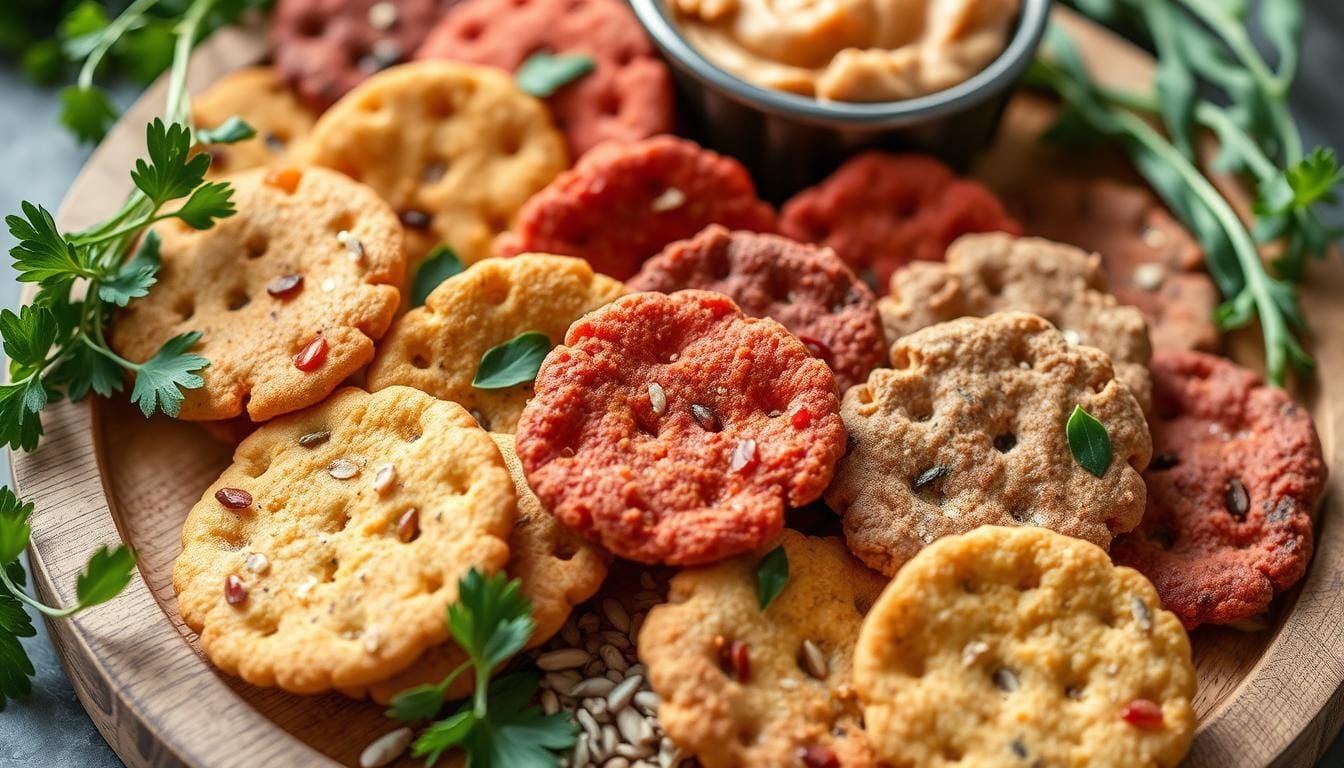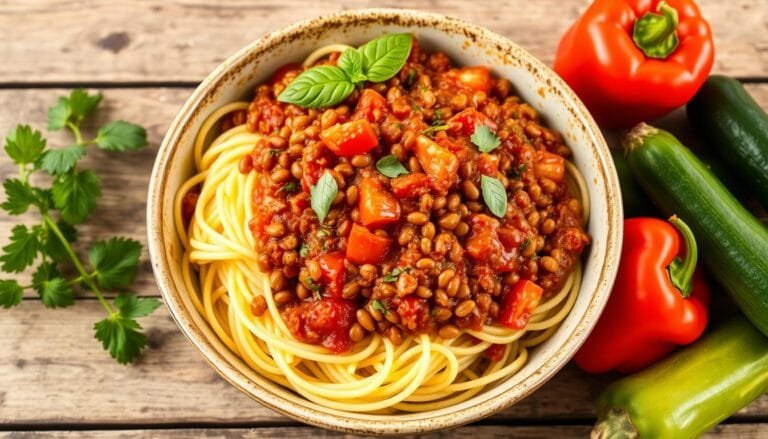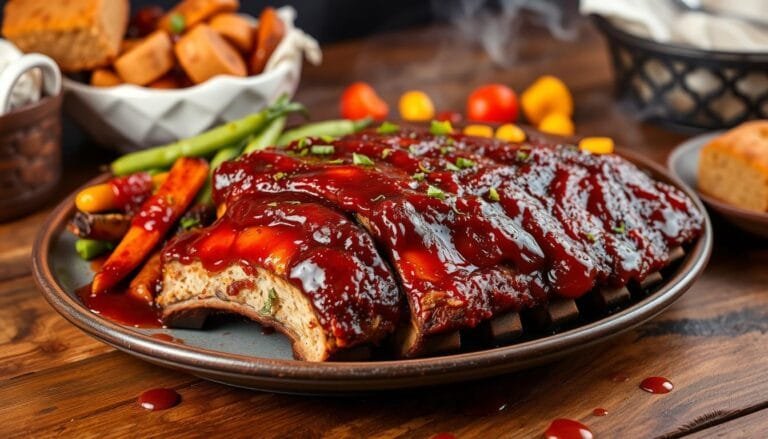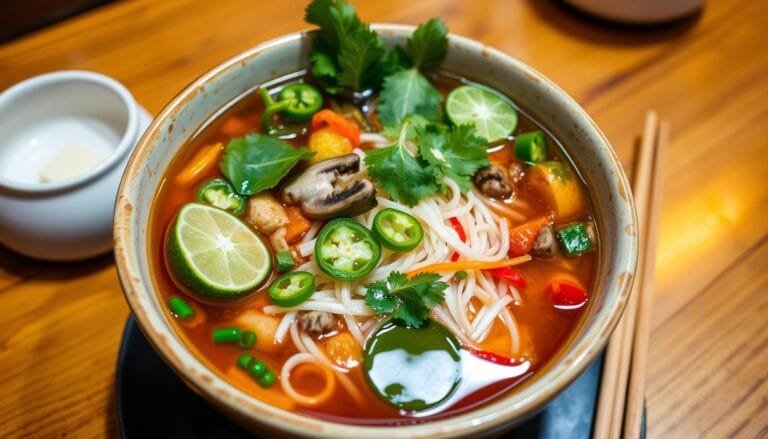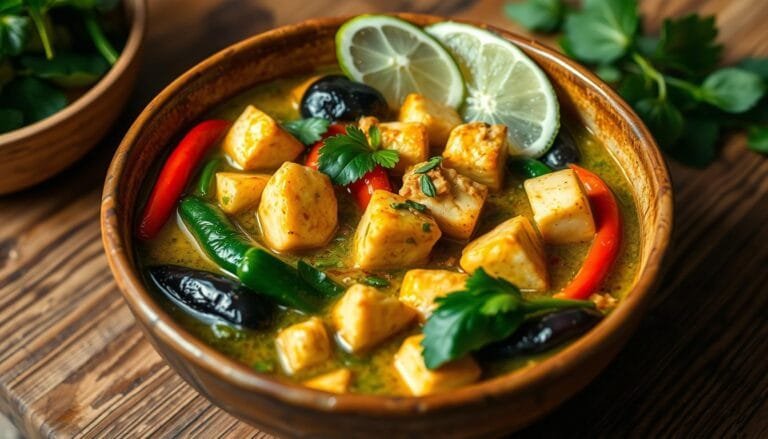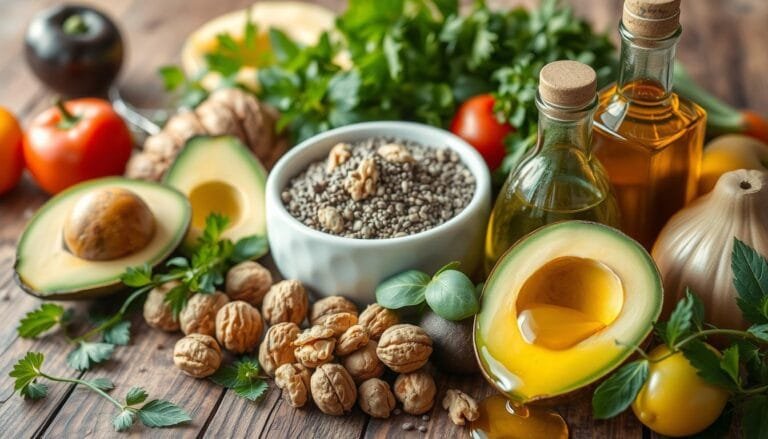I’m always searching for healthy and tasty snacks. That’s why I’m excited to share my recipe for homemade plant-based crackers. They’re easy to make and perfect for snacking. These vegan crackers need only 9 ingredients and are both crispy and flavorful.
This recipe is great because it’s versatile. You can eat the crackers alone or with dips and spreads. Plus, you get about 80 crackers per batch, so you can share or keep them all to yourself.
Making these crackers takes just 33 minutes. They’ve earned a 5-star rating from 25 votes, showing they’re delicious and satisfying. Each serving has 126 calories, 19g of carbs, 3g of protein, and 4g of fat. They’re a guilt-free snack choice.
If you want to avoid processed foods, reduce your environmental impact, or enjoy a healthier snack, try this recipe. You’ll love the fresh flavors and crunchy texture of these homemade crackers!
Why Making Your Own Plant-Based Crackers is Worth It
Making your own plant-based crackers has many benefits. They are cheaper than store-bought ones. Plus, they are better for the environment and let you control what you eat.
Cost-Effective Benefits
Homemade crackers save you a lot of money. For example, a store-bought cracker container costs about $8.99. But, making the same amount at home only costs around $2.49. That’s a big savings of over 70%.
Environmental Impact
Homemade crackers reduce waste. Store-bought ones come in plastic or cardboard, harming the environment. Homemade crackers don’t need all that packaging, making them better for our planet.
Dietary Control Advantages
When you make your own plant-based crackers, you control what goes into them. You can pick healthy, safe ingredients. You can also adjust flavors to fit your diet perfectly.
In summary, making your own homemade crackers is a smart choice. They save money, help the environment, and let you eat what you want. It’s a simple way to make tasty snacks that are good for you.
“The Daring Bakers’ challenge in July 2012 encouraged participants to explore creativity by adding ingredients like seeds, herbs, spices, nuts, or different cheeses to customize their homemade crackers.”
Essential Ingredients for Perfect Crispy Crackers
Making delicious vegan crackers starts with the right ingredients. A mix of vegan cracker ingredients like seeds, chickpea flour, and nutritional yeast is key.
The seed mix is the main attraction. It adds texture and nutrition. Flax, sunflower, pumpkin, and sesame seeds each bring their own taste and health benefits. Chickpea flour, or besan, adds protein and fiber. Nutritional yeast gives a cheesy flavor and B vitamins.
- 2 cups natural almond flour
- 6 tbsp. water
- 2 tbsp ground flaxseed or ground chiaseed
- 1 tbsp dry herb of choice (e.g., oregano)
- 1 tsp fine sea salt
- 1 tsp garlic powder
- Dash of onion powder
Olive oil and water mix the ingredients into a dough. This dough is easy to roll and cut into shapes. By choosing the right vegan cracker ingredients, you make crackers that are tasty, healthy, and crispy.
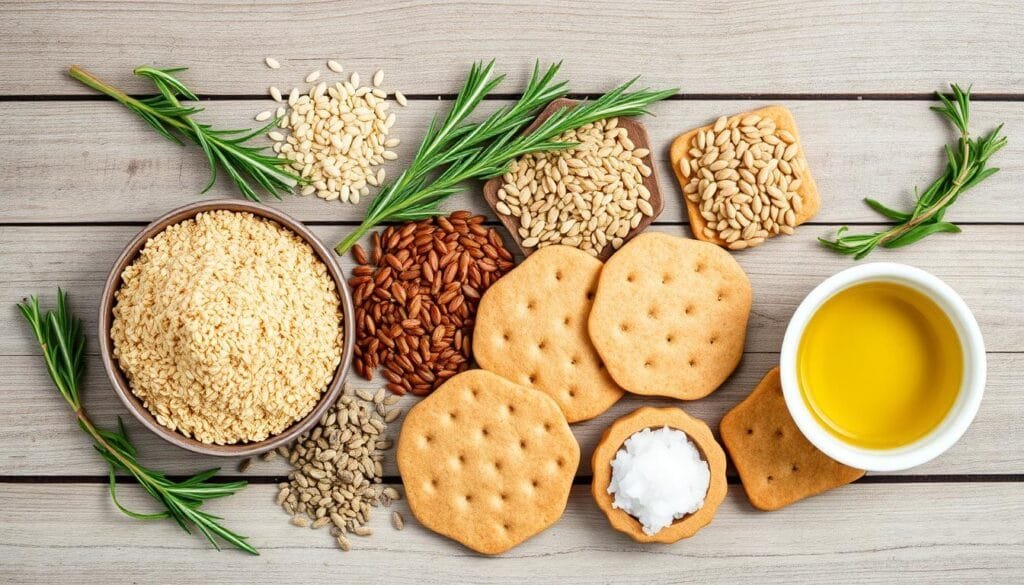
“Homemade crackers have recognizable ingredients compared to processed foods, and they offer a flavorful and healthy alternative to store-bought options.”
This recipe lets you try different seed mixes, spices, and seasonings. You can make savory, herbal, or nutty crackers. The choice is yours with the right mix of chickpea flour and nutritional yeast.
Homemade Plant-Based Crackers: Basic Recipe Guide
Making your own vegan cracker recipe at home is rewarding and fun. With just a few ingredients, you can make crisp, tasty homemade crackers. They’re great for snacking, dipping, or with your favorite dips and spreads. Let’s explore how to make the perfect homemade crackers.
Mixing and Preparation Steps
Start by mixing dry ingredients in a food processor or bowl. Use flours like brown rice and almond, and add seeds like hemp, flax, and sesame. Add baking powder and sea salt for extra flavor and texture.
Then, add a bit of olive oil and water to make a dough. Don’t overwork it to avoid tough crackers.
Rolling and Cutting Techniques
When the dough is ready, split it into two parts. Roll each part between baking paper or parchment to 1/16 inch (1.6 mm) thick. Cut into shapes like squares, rectangles, or triangles with a sharp knife or pizza cutter.
Use a fork to prick the dough to stop it from puffing up while baking.
Baking Instructions
Preheat your oven to 375°F (190°C). Place the crackers on a baking sheet lined with baking paper. Bake for 12 to 18 minutes until they’re golden and crisp. Watch them closely to avoid over-browning.
Let the crackers cool completely on the sheet before serving. This step is key for the perfect crunch. You can also try different seed combinations and seasonings to find your favorite.
“Making your own vegan cracker recipe at home allows you to control the ingredients and create a healthier snack that aligns with your dietary needs and preferences.”
Nutritional Benefits of Seed-Based Crackers
Seed-based crackers are packed with nutrients. They have vitamins, minerals, and healthy fats. These ingredients, like seeds, chickpea flour, and nutritional yeast, make them tasty and healthy.
These crackers have a great nutrient profile. A serving of 8 crackers has 204 calories, 8g of carbohydrates, 7g of protein, and 17g of fats. They also have 9g of polyunsaturated fats, which are good for your heart. Plus, they have 6g of fiber, which helps with digestion and feeling full.
Seed-based crackers are also full of important vitamins and minerals. They have vitamin A, vitamin C, calcium, and iron. These nutrients help keep you healthy, supporting your immune system and bones.
These crackers are also gluten-free, nut-free, and vegan. They’re great for anyone on a plant-based diet, with food allergies, or just looking for a healthy snack.
Next time you want a healthy snack, try seed-based crackers. They’re nutritious and delicious, making them a great addition to your diet.
“These crackers are a game-changer for anyone seeking a wholesome, satisfying snack. The combination of nutrient-dense seeds and chickpea flour makes them a true nutritional powerhouse.”
– Alexandra, Cookbook Author
Equipment and Tools You’ll Need
To make tasty plant-based crackers at home, you’ll need some basic kitchen tools. Start with a mixing bowl or a food processor to mix the dough ingredients well. You’ll also need baking sheets lined with parchment paper for baking the crackers right.
A rolling pin or a sturdy glass bottle is key for rolling the dough thin and even. Use a sharp knife or pizza cutter to cut the dough into cracker shapes. And, a fork is useful for pricking the crackers before baking, making them crisp.
Essential Kitchen Tools
- Mixing bowl or food processor
- Baking sheets
- Parchment paper
- Rolling pin (or sturdy glass bottle)
- Sharp knife or pizza cutter
- Fork
Optional Equipment for Advanced Recipes
If you want to get better at making crackers, consider a stand mixer. It has a strong motor and many attachments, making dough kneading and ingredient mixing easy. Also, a cooling rack helps achieve the perfect crunch as the crackers cool.
Having the right tools makes making homemade plant-based crackers fun and easy. With the right equipment, you’ll create crispy, tasty crackers that will wow your friends and family.
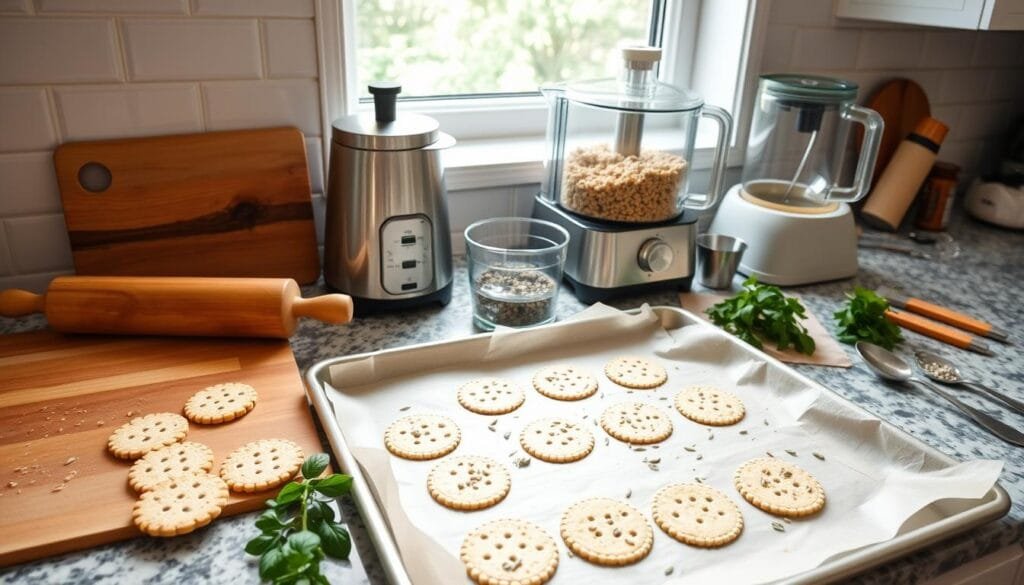
Creative Seasoning Combinations
Make your homemade plant-based crackers more exciting with various seasoning mixes. The basic recipe is a great starting point for your creativity. Try out different cracker seasonings, flavor variations, and herb and spice mixes to make these snacks truly special.
For a savory taste, mix Italian seasoning, nutritional yeast, garlic powder, and chili flakes. Cumin adds a warm, earthy flavor. Rosemary and thyme give a herbal twist, while black sesame seeds and seaweed add an Asian touch.
Don’t hesitate to use fresh herbs like parsley, dill, or chives. They can make your crackers taste fresh and exciting. The world of cracker seasonings and flavor variations is vast and full of possibilities.
The basic recipe for these crackers is very flexible. You can try many herb and spice mixes to match your taste or go with different dips. Let your creativity shine and find your unique cracker flavor!
“The key to creating mouthwatering plant-based crackers is to have fun with flavor variations and embrace your creativity in the kitchen.”
Storage Tips and Shelf Life
Keeping your homemade plant-based crackers fresh is key for a great snack. Here are some easy tips to keep them crisp:
Best Storage Containers
- Use an airtight container like a glass jar or metal tin to keep out moisture and air.
- Stay away from plastic bags, as they can make crackers soggy by trapping humidity.
- For an extra seal, try a vacuum sealer to keep your cracker storage fresh longer.
Maintaining Freshness
Your homemade snacks can stay fresh for up to a week at room temperature. For longer storage, try these options:
- Keep crackers in the fridge for 2-3 weeks to keep them crisp.
- Freeze them in an airtight container or bag for 6-8 months.
If your crackers get soft, just warm them up in a low oven (300°F/150°C) for a few minutes. They’ll crisp up again.
| Storage Method | Shelf Life |
|---|---|
| Airtight container at room temperature | Up to 1 week |
| Refrigerator | 2-3 weeks |
| Freezer | 6-8 months |
Always check your stored crackers for mold, texture changes, or bad smells. Good cracker storage and preserving homemade snacks means you can enjoy them longer.
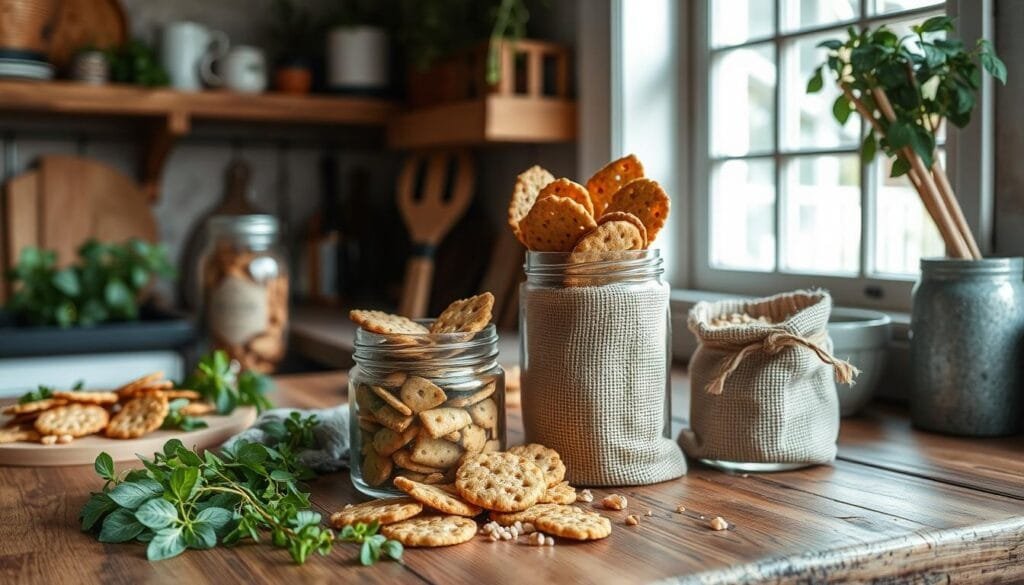
Troubleshooting Common Cracker-Making Issues
Making homemade plant-based crackers can be rewarding, but you might face some challenges. With a bit of troubleshooting and adjustments, you can fix these issues. Let’s look at common problems and how to solve them.
Uneven Baking
If your crackers bake unevenly, it’s often because of uneven dough thickness. Make sure to roll out the dough evenly. This ensures all crackers bake the same, giving them a crisp texture.
Excessive Bubbling
Large air bubbles on your crackers can be a problem. To fix this, prick the dough with a fork before baking. This lets air out, preventing bubbles and giving you a flat cracker.
Lack of Crispness
If your crackers aren’t crisp enough, try a few things. Bake them a bit longer, but watch them to avoid over-browning. Also, let them cool completely before checking their texture. Warm crackers might seem softer than they will once cool.
Crumbly Texture
For crumbly crackers, find the right mix of seeds. Use small seeds like flax or chia and larger seeds like sunflower or pumpkin. This mix helps the dough stick together, making the crackers sturdy.
Remember to turn the baking tray halfway through baking for even browning. With these tips, you’ll make perfect, crispy crackers every time.
| Issue | Solution |
|---|---|
| Uneven Baking | Ensure even dough thickness when rolling out |
| Excessive Bubbling | Prick dough with a fork to allow air to escape |
| Lack of Crispness | Extend baking time and allow crackers to cool completely |
| Crumbly Texture | Balance small and large seeds in the recipe |
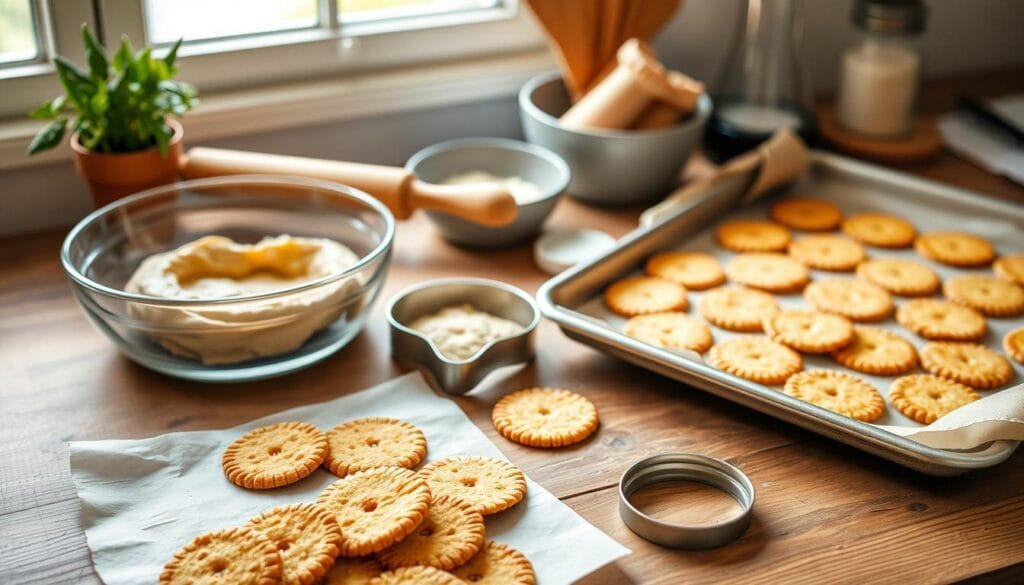
“Baking homemade crackers is a labor of love, but the end result is so worth it. With a little troubleshooting, you can create the perfect crispy, flavorful crackers that are sure to impress.”
Pairing Suggestions and Serving Ideas
Homemade plant-based crackers are super versatile. They pair well with many dips, spreads, and toppings. They’re great for showing off your favorite vegan dips like hummus, guacamole, or caramelized onion spread. They also make a fantastic base for cracker pairings with plant-based “lox” or other savory toppings.
These healthy snack ideas are not just for snacks. You can use them in meals in creative ways. Try them as a crunchy topping for salads or soups. Or serve them with a plant-based cheese board for a fun snack time. They’re also great in lunchboxes, adding crunch and nutrients to your lunch.
Dips and Spreads
- Hummus
- Guacamole
- Vegan Cheese Spread
- Caramelized Onion Dip
- Plant-Based “Lox”
Meal Integration Ideas
- Crunchy Topping for Salads
- Accompaniment to Soups
- Part of a Vegan Cheese Board
- Addition to Lunchboxes
These homemade cracker pairings are not only tasty but also full of nutrients. They’re a great, healthy snack option. Try different vegan dips and ways to use them in meals. Find your favorite flavors and enjoy these healthy snack ideas in many ways.
Gluten-Free and Allergen-Friendly Variations
Healthy snacking needs to meet many dietary needs and preferences. That’s why we offer homemade gluten-free crackers and allergen-free snacks. They’re for everyone, including those with food sensitivities or restrictions.
To make these vegan crackers gluten-free, we mix chickpea flour, brown rice flour, and sorghum flour. This blend creates a crisp and flavorful cracker without wheat or gluten. The seed-based recipe is also nut-free, making it safe for those with nut allergies.
We’re all about being open and safe with allergens. Always check the ingredients for allergens, like in pre-mixed seasonings or nutritional yeast. With a bit of care, you can make this recipe fit many dietary needs. This way, everyone can enjoy homemade crackers.
“The demand for gluten-free and allergen-friendly snacks continues to grow, with 52% of global consumers actively seeking out these options.”
Our cracker recipe is perfect for personal preferences or supporting loved ones with dietary needs. It offers a great mix of crunch, flavor, and nutrition. Plus, it meets your unique dietary requirements.
Time-Saving Tips and Batch Preparation
As a home baker, I’ve found great ways to save time. Making bulk cracker baking easier is one of them. I prepare big batches of dry ingredients to use later. This saves time and makes sure I have what I need for quick meal prep snacks.
Baking many trays at once is another big help. It uses my oven space well, saving time without losing quality. On busy days, I bake extra and freeze them for later.
- Pre-mix spice blends to speed up the process
- Use a food processor for quick, even mixing
- Roll the dough between parchment paper for easy transfer and cleanup
These tips have changed how I make crackers. Now, I enjoy making them and love the tasty results. With a bit of planning, I always have homemade meal prep snacks ready to go.
| Ingredient | Quantity | Purpose |
|---|---|---|
| Almond Flour | 2 cups | Provides a rich, nutty flavor and texture |
| Ground Flaxseed | 1/4 cup | Adds fiber and healthy omega-3s |
| Water | 1/4 cup | Binds the ingredients together |
| Olive Oil | 2 tablespoons | Enhances crispiness and moisture |
| Salt | 1/2 teaspoon | Balances the flavors |
| Garlic Powder | 1/2 teaspoon | Adds savory depth |
| Rosemary | 1 teaspoon, dried | Provides an aromatic, earthy note |
Recipe Variations and Flavor Combinations
Homemade crackers are incredibly versatile. I enjoy trying out different seed mixes, flours, and spices. This lets me create unique flavors for everyone’s taste and dietary needs. For a nutty taste, I add hemp, flax, sunflower, pumpkin, sesame, or poppy seeds. Dried fruits like cranberries or apricots add a sweet-and-savory flavor.
Changing the flours can also bring new tastes. Almond or coconut flour adds richness, while whole wheat or oat flour makes them heartier. Spices like curry powder, za’atar, or everything bagel seasoning can make the crackers truly special. For a cheesy flavor, a bit of miso paste or vegan cheese works great.
The basic cracker recipe is like a blank canvas for me. I can make them savory, sweet, or a mix of both. Homemade crackers let me satisfy my cravings and dietary needs. They’re a versatile and satisfying snack.
